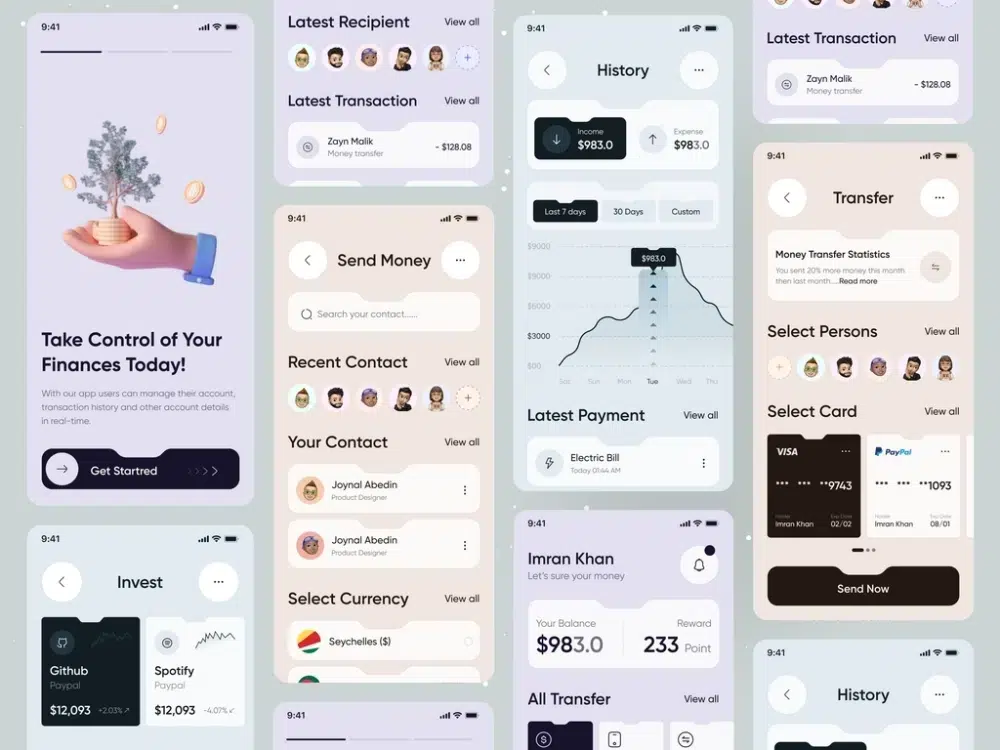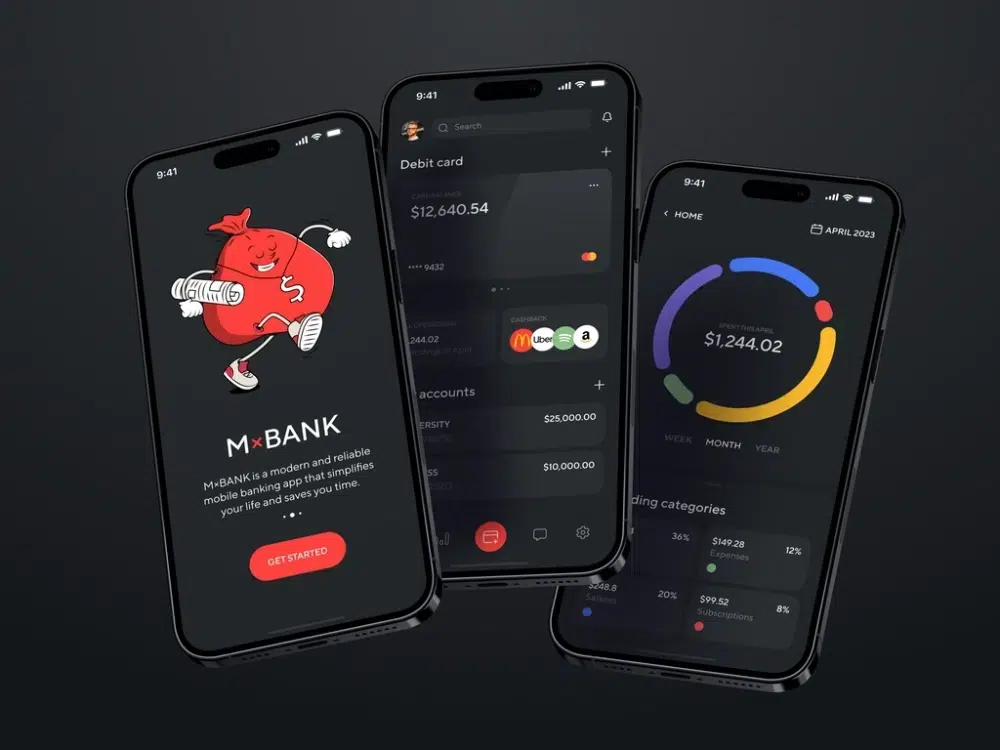Why Would You Use React Native For Banking App Development?
Banking apps were born to make financial activities more accessible, and they are now among the fastest-growing app segments.
The characteristics of a banking app revolve significantly around real-time processing, velocity, security, and user-friendliness. Banking app development can be very complicated and time-consuming, for it has to meet all these requirements to win customers’ hearts.
There are several popular programming languages that developers use to improve their work quality and reduce the time it takes to create a banking app, one of which is React Native for the app frontend. However, before you decide to go all-in with React Native, you should first grasp how it works and determine whether it is the best fit for your project.
In this article from Savvycom, we will explain this framework so you can make an informed decision about whether React Native is right for your company.
1. What Is React Native?
React Native (or RN) is a popular JavaScript-based mobile app framework that allows you to develop natively rendered iOS and Android mobile apps.
To be more specific, it means you may make use of the major advantages of React.js app development, such as faster time to market, simplicity of use, rapid work, efficient developer tools, and so on. The framework enables you to design applications for several platforms using a single codebase.
- React Native aims at providing a fantastic mobile user experience, making it a good choice for apps that demand high responsiveness and straightforward use, like banking apps.
- Facebook released React Native as an open-source project in 2015. Some of the world’s most popular mobile apps, such as Instagram, Facebook, and Skype, are built with React Native.
React Native is an open-source framework for building mobile applications using JavaScript and React, a popular JavaScript library for building user interfaces. It allows developers to create mobile apps that run on both iOS and Android platforms using a single codebase. React Native uses native components, providing a native-like user experience and performance. It offers features like hot reloading for faster development, code reusability, and a vast ecosystem of libraries and modules for extending functionality. Overall, React Native simplifies mobile app development by leveraging web development skills while delivering the performance of a native app.
2. Examples of Successful React Native App
React Native has been utilized by numerous successful apps across various industries. Here are a few notable examples:
-
Facebook Ads Manager is an app developed by Facebook using React Native. It allows advertisers to create, manage, and track their ad campaigns on the Facebook platform. React Native’s cross-platform capabilities enabled Facebook to streamline the development process and deliver a consistent experience across iOS and Android.
-
Instagram: Although not the entire Instagram app, certain features of Instagram have been built using React Native. For instance, the Explore tab, which displays personalized content recommendations, is developed with React Native. This demonstrates the scalability and performance of React Native even for large-scale apps.
-
Airbnb is a popular online marketplace for lodging and accommodations, has leveraged React Native for their mobile app. React Native enabled Airbnb to deliver a native-like experience to both iOS and Android users while reducing development time and effort.
-
Bloomberg is a renowned financial information and news service, has incorporated React Native into their mobile app development. React Native allowed Bloomberg to efficiently develop and maintain their app while providing users with real-time financial news, market data, and portfolio management tools.
-
Discord is a popular communication platform for gamers and communities, has utilized React Native for their mobile app. React Native’s performance and code sharing capabilities helped Discord deliver a responsive and feature-rich experience to millions of users across different platforms.
These examples highlight the success and versatility of React Native in powering applications across diverse industries. React Native’s ability to achieve native-like performance and its efficiency in cross-platform development make it a compelling choice for building successful apps.
4. Examples of banking app created using react native
While I don’t have access to real-time data or an exhaustive list of all banking apps developed using React Native, I can provide you with a few examples of banking apps that have been built using React Native:
-
Santander Mobile Banking: Santander, a global bank, has developed its mobile banking app using React Native. The app allows users to manage their accounts, make payments, transfer funds, view transaction history, and access various banking and financial services.
-
NuBank is a popular digital bank based in Brazil, has developed its mobile banking app using React Native. The app offers a range of banking services, including account management, money transfers, bill payments, credit card management, and customer support.
-
Chime is a mobile banking platform in the United States that provides online banking services. Their banking app is built using React Native and offers features like mobile check deposit, peer-to-peer payment solutions, spending insights, and access to fee-free ATMs.
-
Kuda is a Nigerian digital bank that offers financial services through its mobile app. The app, built with React Native, enables users to open accounts, send money, make payments, and track their spending. It also provides features like budgeting tools and savings options.
-
Monzo is a UK-based digital bank that has gained popularity for its mobile banking app. The app, built using React Native, provides features like instant notifications, budgeting tools, spending categorization, and real-time balance updates. Users can also make payments, set financial goals, and manage their accounts easily.
-
Revolut is a digital banking and financial services app that offers various features like money transfers, currency exchange, budgeting tools, and investment options. Their app, developed with React Native, provides a user-friendly interface for managing personal finances.
-
N26 is a German neobank that operates across Europe and the United States. Their mobile banking app, built using React Native, allows users to open accounts, manage transactions, set savings goals, and control their finances through various features and integrations.
-
Ally Bank is a US-based online bank that provides banking and investment services. Their mobile app, developed using React Native, offers features like mobile check deposit, fund transfers, bill payments, and access to investment accounts.
Have a Project Idea in Mind?
You are more than welcome to contact our Partnership Manager for a free consultation.
5. the pros of using react native in banking app development
These are just a few examples of banking apps that have utilized React Native. Each app offers a range of services and features tailored to their specific target audience and region. The use of React Native allows these banking apps to deliver a consistent and intuitive user experience across different platforms while streamlining the development process.
React Native offers several advantages that make it a good choice for developing banking apps:
-
Cross-platform development: React Native allows you to build banking apps that can run on both iOS and Android platforms using a single codebase. This cross-platform capability saves time and resources compared to developing separate native apps for each platform.
-
Native-like performance: React Native bridges the gap between native and hybrid apps by using native components and compiling the code into native code. This ensures that the banking app performs at a high level, providing a smooth and responsive user experience.
-
Code reusability: With React Native, you can reuse a significant portion of the code across different platforms. While some platform-specific code may be necessary, the shared codebase reduces development time and effort, making it easier to maintain and update the banking app.
-
Fast development cycles: React Native’s hot reloading feature enables developers to see real-time changes in the app without recompiling the entire application. This speeds up the development process, allowing for quick iterations and faster time-to-market.
-
Vast ecosystem of libraries and modules: React Native has a thriving ecosystem of third-party libraries and modules. This provides access to a wide range of features, integrations, and security components that are essential for banking app development. These libraries can help with secure authentication, data encryption, payment gateways, and more.
-
Developer community and support: React Native has a large and active community of developers who contribute to its growth and provide support. This community-driven ecosystem ensures that developers can find resources, tutorials, and guidance while developing the banking app.
-
Cost-effective solution: By using React Native, you can save development costs compared to building separate native apps for each platform. The code reusability and faster development cycles result in reduced time and effort, making it a cost-effective digital banking solution for banking app development.
However, it’s crucial to note that security is of utmost importance for banking apps. While React Native provides a strong foundation, implementing proper security measures, such as secure data storage, encryption, and adherence to security best practices, is essential to ensure the app’s safety and protect user data.
6. Some drawbacks of react native in banking app development you should know about
While React Native offers several advantages for banking app development, it also has some potential drawbacks to consider:
- Performance limitations for complex functionalities or graphics-intensive tasks.
- Limited access to device-specific features, requiring additional development or integration with native code.
- Larger app size compared to fully native apps, potentially impacting storage and download speed.
- Security considerations: Proper security measures need to be implemented to protect sensitive user information.
- Dependency on React Native updates, requiring compatibility checks and potential additional development.
- Learning curve for developers who are new to JavaScript and React.
Despite these drawbacks, many successful banking apps have been developed using React Native. By considering these limitations and applying best practices, it is possible to overcome challenges and build secure and high-performing banking apps with React Native.
7. Vietnam – the ideal IT outsource destination for your next banking & finance app
Vietnam has emerged as a favorable destination for banking app development for several reasons.
- Firstly, Vietnam boasts a large pool of highly skilled and cost-effective software developers. The country has a thriving tech industry, and its developers are known for their proficiency in various programming languages, including those used in mobile app development such as React Native.
- Secondly, Vietnam offers a competitive business environment with supportive government policies, making it an attractive destination for foreign investment. Additionally, the lower cost of living and labor compared to many Western countries can result in cost savings for banking app development projects.
- Lastly, Vietnam has a strong educational system, producing a steady stream of IT graduates who are eager to contribute to the growing technology sector. These factors make IT companies in Vietnam an appealing choice for banking app development, offering a combination of talent, affordability, and a conducive business environment.
Takeaway
React Native is an excellent solution for developing apps that operate seamlessly on any platform or system. It’s a popular framework among both corporations and developers. It helps you to save a significant number of labor hours, resulting in a speedier development process that is also cost-effective.
To decide if you prefer using React native for your banking app, you will need advice from experienced developers. They are the ones who work with this framework so they are aware that it would be suitable for your app based on the requirements. If you have an idea for your banking app and need consultation, don’t hesitate to contact us!
Savvycom – Your Trusted Tech Partner
From Tech Consulting, End-to-End Product Development to IT Outsourcing Services! Since 2009, Savvycom has been harnessing the power of Digital Technologies that support business’ growth across the variety of industries. We can help you to build high-quality software solutions and products as well as deliver a wide range of related professional services.
Savvycom is right where you need. Contact us now for further consultation:
- Phone: +84 24 3202 9222
- Hotline: +84 352 287 866 (VN)
- Email: [email protected]
Can I use native code in a React Native app?
Yes, React Native allows for the integration of native code written in Swift (for iOS) or Java/Kotlin (for Android) for specific functionalities or optimizations. This capability is useful when accessing device-specific features or enhancing performance.
How does React Native achieve cross-platform compatibility?
React Native achieves cross-platform compatibility by utilizing a "write once, run anywhere" approach. The majority of the codebase is written in JavaScript, which is then translated into native code for each platform during runtime, resulting in apps that can run on both iOS and Android.
What are the advantages of using React Native over other frameworks?
Some advantages of React Native include code reusability, faster development cycles with hot reloading, access to native components, a large community and ecosystem, and the ability to leverage existing web development skills.
Can I migrate an existing native app to React Native?
Yes, it is possible to migrate an existing native app to React Native. However, the complexity of the migration depends on the size and complexity of the app. Some parts of the app may need to be rewritten, while others can be reused through bridging techniques.
Is React Native suitable for building complex apps?
Yes, React Native is capable of building complex apps, including those with advanced UI/UX requirements. However, in some cases, certain functionalities may require custom native development or optimization to achieve optimal performance.
What companies are using React Native?
Several well-known companies use React Native for their apps, including Facebook, Instagram, Airbnb, Walmart, Tesla, Bloomberg, and SoundCloud.
Is React Native only for mobile app development?
While React Native is primarily used for mobile app development, there are efforts to extend its capabilities to other platforms, such as desktop and web applications, through projects like React Native for Web and React Native Windows.







